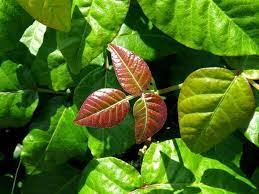There’s an old saying- “Leaves of three, let them be.”
What is the Difference Between Poison Oak and Poison Ivy?
Poison oak is a relative of poison ivy. There are many similarities:
Both plants contain the same toxic resin, urushiol, in all parts of the plant (toxic to humans but harmless to animals).
Both plants have three leaflets, white flowers in spring, and can grow as a vine or a shrub.
Leaflets can range in size from the length of your thumb to the length of your hand.
A middle leaflet has a notably longer stem than the two side leaflets, though more obvious in poison ivy than in poison oak.
Depending on the season, leaf color can range from green to orange and even a dark purplish-red.
But they are indeed different plants. In North America, there are two species of poison oak: Atlantic (Eastern) and Pacific (Western).
How to Identify Poison Oak
Poison oak is a low-growing, upright shrub that can reach about 3 feet tall, sometimes resembling a vine.
The leaf shape resembles an oak leaf (hence the name, poison oak), but it’s not a member of the oak family.
Leaflets are duller green than poison ivy and usually more distinctly lobed or toothed.
Leaflets have hairs on both sides, unlike poison ivy.
Poison oak tends to grow at elevations between sea level and 5,000 feet.
While the fruit of poison ivy is the color of pearls, poison oak fruit (called “drupes”) is tan.
At the end of the day, remember: Leaves of three, let it be. In other words, if you see a plant with clusters of three leaves, don’t touch it!
The Problem: Urushiol
Poison ivy, poison oak and poison sumac all contain urushiol. This oily sap can be found in all parts of the plant — the leaves, stems, fruit and even the roots — and is released when any part of the plant is bruised, damaged or burned. For up to 85% of people, urushiol is an allergen that causes a skin rash on contact. However, when urushiol makes contact with your skin, it doesn't cause immediate problems. It can take up to 72 hours for your body's immune system to recognize the allergen as a threat and respond.
The immune response leads to inflammation, redness and the development of itchy blisters. In some cases, swelling, oozing and even infection can occur. The severity of the reaction varies, depending on the amount of exposure to urushiol and your sensitivity.
The Rash
The first signs of a poison oak, ivy or sumac reaction is going to be some itching and swelling. Then you will begin to notice some redness and small blisters forming. The blisters form and couple in a chain-like reaction and they are filled with fluid. Once the blisters pop or ooze they create a yellowish crust. If a rash is left untreated, it can last up to 3-5 weeks, but a typical reaction that is well taken care of, will only last about 5-12 days.
Taking care of the rash properly is extremely important! As soon as you notice some itchiness, wash with cold water and soap right away!
Dawn soap works well or a specialty soap like a mugwort or jewelweed soap. Wash and scrub the infected area, rinse, wash and scrub again, rinse and repeat. The key is to remove the Urushiol oil before it spreads.
If you do still end up getting a rash, make sure to keep it clean and ease the pain and itchiness with Skitch Itch Balm. Once you have cleaned the urushiol oils off of the rash, touching the rash and then touching another part of your non-infected skin will NOT make the rash spread. This is a common misconception.
